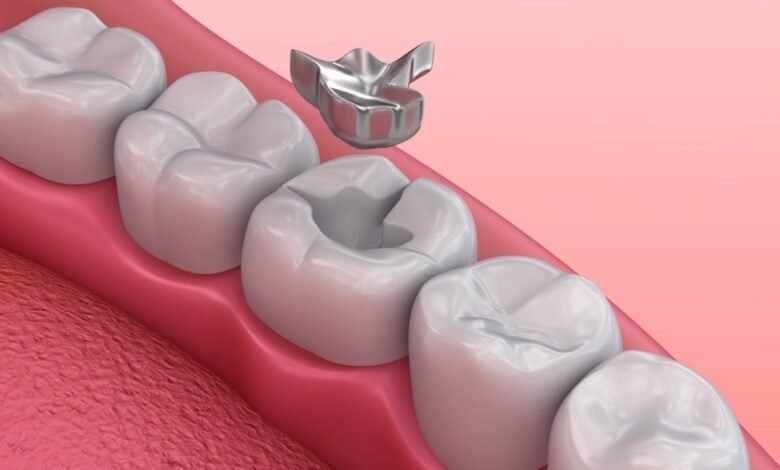Dental Fillings in the UK: Everything You Need to Know

Tooth decay is a common problem, and when it strikes, dental fillings often become the essential solution. In the UK, a range of options and considerations influence the type of filling you receive. Whether you’re experiencing your first cavity or simply want to stay informed, this comprehensive guide delves into everything you need to know about dental fillings in the UK.
Types of Dental Fillings
Amalgam Fillings
The traditional “silver fillings,” amalgams are a sturdy and durable option made from a blend of metals, including mercury. Though their use is gradually declining due to environmental concerns, they remain a cost-effective choice for NHS coverage, particularly for back teeth. However, pregnant women, breastfeeding mothers, and children under 15 are generally advised against them.
Composite (White) Fillings
Tooth-colored and aesthetically pleasing, composite fillings bond directly to the tooth, offering a natural look for front teeth. While slightly less durable than amalgams, they’re a popular choice for their aesthetics and ease of placement. Note that they may incur additional costs beyond NHS coverage.
Glass Ionomer Fillings
Often used for children’s teeth or in areas at risk of future decay, glass ionomer fillings release fluoride, promoting tooth health. They’re less wear-resistant than composites but offer additional cavity prevention benefits.
Inlays and Onlays
For larger cavities or weakened teeth, inlays and onlays provide extra stability and support. These tooth-colored restorations are custom-made in a lab and bonded to the tooth, offering an alternative to crowns for teeth requiring significant repair.
Factors Affecting Choice
Several factors influence the type of filling your dentist recommends:
- Location of the cavity: Front teeth generally receive white fillings for aesthetic reasons, while back teeth may use amalgams for durability.
- Size and severity of the cavity: Larger cavities may require stronger materials like inlays or onlays.
- Cost: While some fillings are covered by the NHS, others incur additional costs. Discuss options and budget limitations with your dentist.
- Patient preferences: Some may prioritize aesthetics and opt for white fillings, while others value durability and cost-effectiveness.
NHS and Private Costs
The National Health Service (NHS) covers amalgam fillings and, in some cases, white fillings on front teeth. However, additional costs may be incurred for lab-made restorations like inlays or onlays and certain aesthetic options. Private dental practices offer a wider range of materials and techniques, which typically come at a higher cost.
Procedure and Aftercare
The filling procedure typically involves removing decayed tooth material, cleaning the area, and placing the chosen filling material. Local anesthesia is usually used to ensure comfort. Aftercare involves good oral hygiene practices and regular dental checkups to monitor the filling and overall oral health.
Beyond Fillings: Preventive Measures
While fillings are an effective treatment for existing cavities, prevention is key. Brushing twice daily, flossing regularly, and maintaining a healthy diet rich in calcium and low in sugar can significantly reduce the risk of tooth decay and the need for future fillings.
Conclusion
Dental fillings are a common and effective treatment for cavities in the UK. Understanding the different types, factors influencing choice, and NHS coverage options empowers you to make informed decisions about your dental care. Remember, prevention is always the best approach, so prioritize good oral hygiene and regular dental checkups to maintain a healthy smile.
FAQs
Q. What are dental fillings?
A. Dental fillings are materials used to repair teeth that have been damaged by decay or cavities. They help restore the function and structure of the tooth.
Q. What types of dental fillings are available in the UK?
A. Common types of dental fillings used in the UK include amalgam fillings (a mixture of metals), composite resin fillings (tooth-colored fillings), gold fillings, and porcelain fillings.
Q. How long do dental fillings last?
A. The lifespan of a dental filling depends on factors such as the type of filling material used, the location of the filling in the mouth, oral hygiene practices, and the individual’s diet. On average, dental fillings can last anywhere from 5 to 15 years.
Q. Are dental fillings covered by the NHS?
A. Dental fillings are usually covered by the NHS if they are deemed necessary for maintaining oral health. However, the type of filling material provided may depend on the dentist’s assessment and the patient’s preferences.
Q. Do dental fillings hurt?
A. The process of getting a dental filling typically involves administering local anesthesia to numb the area being treated, so patients usually do not experience pain during the procedure. However, some individuals may feel discomfort or sensitivity afterward, which usually subsides within a few days.


